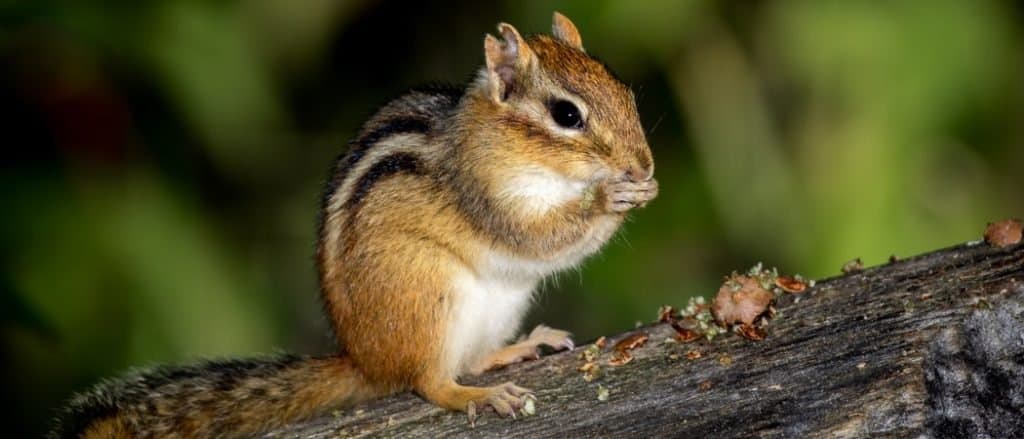Our world displays significant biodiversity. Although each species has traits that distinguish it from the others, the gopher and the chipmunk are sometimes confused for each other. Chipmunks and gophers are rodents that prove to be the largest group of mammals. They are comparable in size but differ significantly in body structure, color pattern, and behavior. In addition, chipmunks belong to the Sciuridae family, which includes the vast family of squirrels, while gophers belong to the Geomyidae family. Apart from these, what are the other differences between chipmunks vs gophers? Let’s explore the characteristics that distinguish the two animals below.
Comparing a Chipmunk and a Gopher

| Chipmunk | Gopher | |
|---|---|---|
| Appearance | – has a slim and athletic body- fur is brown with black stripes | – stockier- fur can be black, brown, gray |
| Mounds | – digs a small hole in their burrow entrance | – creates a pattern like a honeycomb |
| Diet | – omnivores | – herbivores |
| Times Active | – active during dark and dawn-hibernates in winter | – active during the day- active throughout the year |
| Behavior | – social animals | – lives alone but share their burrows with other creatures |
The 5 Key Differences Between a Chipmunk and a Gopher
The main differences between a chipmunk and a gopher include their appearance, mounds, diet, times of activity, and behavior. While it’s important to distinguish the two, chipmunks and gophers are prevalent yard pests for many homes. Both are garden pests that steal food and burrow holes in the ground. Their burrowing can undermine infrastructures like patios, stairs, and housing foundations.
A chipmunk is a small, striped rodent native to North America and Asia, while a gopher is a small, furry rodent found in North and Central America. These two animals couldn’t be more different, and we’ll go through each of their differences in detail.
Chipmunk vs Gopher: Appearance

Chipmunks are almost always brown with black stripes.
©RT Images/Shutterstock.com
Chipmunks have a slim and athletic body, weighing about 57–113 grams. They are almost always brown with black stripes on their heads, necks, backs, and tails. In addition to strips, stubby legs and bushy tails are their characteristic features. Some may have brown or white color strips that are equally good.
A gopher appears larger, with a stockier frame and a weight of around 220–1000 grams. They feature small eyes and ears, and they have no distinct neck. In addition, gophers have brown, gray, or black fur. They have fur-lined cheek pockets, earning them the name “pocket gopher”.
Chipmunk vs Gopher: Mounds
Chipmunks and gophers are rodents that burrow into the ground, and because of this, they are known as pests as they weaken plants and structures. While chipmunks dig small holes on the land, they can also make nests in trees. Chipmunks dig burrows up to 30 feet long with small entrance holes. They also store their food in their tunnels. Chipmunks aren’t particularly aggressive. As a result, they pose no harm to humans or pets. However, the burrowing can make the lawn look unsightly, and the feeding can harm plants in the backyard garden.
Gophers have bodies built for digging. Their burrows are 200–2,000 square feet in size, with six-foot-deep food storage chambers. They are known as “burrowing rodents” because of their tunneling activities. They construct shallow tunnels for foraging and dig holes similar to honeycombs. The lawn, trees, plants, and crops are all at risk from these rodents. These species are also rabies carriers. They have fleas and ticks, which harm human health.
Chipmunk vs Gopher: Diet

While gophers are herbivores, chipmunks are herbivores.
©eumates/Shutterstock.com
Chipmunks are omnivores and feed on seeds, grains, nuts, berries, and mushrooms. They also eat baby birds, frogs, insects, and bird eggs. They store extra food in their cheek pouches and burrows. Garlic, peppermint, lemon, cinnamon, and eucalyptus are all offensive to these rodents. Hence, this is the most effective approach to getting rid of chipmunks.
Gophers are herbivores interested in roots and tubers, and they also eat the tops of small plants occasionally. The gopher is known as the “pocket gopher” because it transports its food from the source to its tunnels using its furry cheek pouches. It also creates six-foot-deep storage chambers for food storage. Peppermint is repulsive to gophers. Thus, this is the most natural way to keep gophers out of your yard.
Chipmunk vs Gopher: Active Times
Chipmunks are most active at night and early in the morning. They also hibernate in the winter, and instead of accumulating fat around their bodies like bears, they put extra food into their cheek pouches and store it in their habitat. They appear to be dead during hibernation – their heart rate lowers from 350 to 4 beats per minute, and their body temperature dips from 94 degrees to 40 degrees Fahrenheit.
Gophers are exclusively active throughout the day, with intervals of activity alternating with rest. They rarely emerge from their tunnels, but they may do so at night or on cloudy days. They are also active all year round because they do not hibernate.
Chipmunk vs Gopher: Behavior
Chipmunks are social creatures, yet they don’t like sharing their tunnels. They also emit high-pitched chirps (vocal animals), which aid in pest identification. They give birth once or twice a year, with the first mating occurring in early spring and the second occurring in early summer, whereas western chipmunks only breed once a year. Despite their diminutive size, they help and contribute to the forest ecology. Their average lifespan is three years, but a few live for nine years (in captivity).
While gophers are not particularly social, they do enjoy sharing their tunnels with other animals. They also eat, sleep, and give birth underground. Gophers are not particularly vocal, making little to no sounds. They give birth three or more times a year and live for three years. However, five years is considered the maximum.
The photo featured at the top of this post is © Emmily/Shutterstock.com
Thank you for reading! Have some feedback for us? Contact the AZ Animals editorial team.






